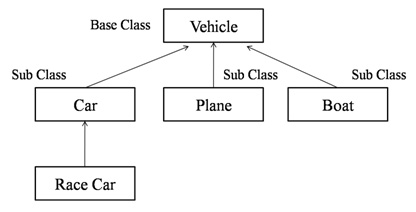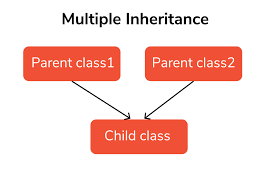Python Inheritance Constructor | Super | Override | Init | Example

Multiple Inheritance in Python:
In Python, multiple inheritance refers to the ability of a class to inherit attributes and methods from multiple parent classes. This means that a class can inherit from more than one base class, allowing it to combine and reuse functionality from different sources. To implement multiple inheritance in Python, you can define a class with multiple base classes in the class declaration.
Here’s an example that demonstrates multiple inheritance in Python:
class BaseClass1:
def method1(self):
print("BaseClass1 method")
class BaseClass2:
def method2(self):
print("BaseClass2 method")
class DerivedClass(BaseClass1, BaseClass2):
def method3(self):
print("DerivedClass method")
# Create an instance of the derived class
obj = DerivedClass()
# Access methods from BaseClass1
obj.method1()
# Access methods from BaseClass2
obj.method2()
# Access methods from DerivedClass
obj.method3()
In the example above, DerivedClass is derived from both BaseClass1 and BaseClass2 using multiple inheritance. The DerivedClass inherits the methods method1 from BaseClass1 and method2 from BaseClass2. It also defines its own method method3.
When an object DerivedClass is created, it can access methods from all the inherited classes. In this case, obj.method1() calls the method1 form BaseClass1, obj.method2() calls the method2 from BaseClass2, and obj.method3() calls the method3 defined in DerivedClass.
Python multiple inheritance init
In the case of multiple inheritance, the __init__ method of each parent class needs to be handled appropriately in the child class. This can be achieved by explicitly calling the __init__ methods of the parent classes using the super() function in the child class’s __init__ method.
The order in which the parent classes are specified in the child class declaration determines the order of initialization. Each __init__ method is called in the reverse order of the parent class list, with the deepest parent class being initialized first.
It’s important to handle the initialization process carefully to avoid potential conflicts or unintended behavior. Understanding the method resolution order (MRO) and the order in which the super() function is crucial for managing multiple inheritance and the initialization process effectively.
By properly managing the initialization process in multiple inheritance scenarios, you can combine and utilize attributes and methods from multiple parent classes in a child class, creating flexible and powerful class hierarchies.
Python inheritance constructor
In Python, when a class inherits from a parent class, you can override the parent class’s constructor (also known as the initializer) in the child class. This allows you to customize the initialization process for the child class while still benefiting from the parent class’s attributes and methods.
To override the constructor in the child class, you need to define a new constructor method with the same name as the parent class’s constructor. Within the child class’s constructor, you can choose to call the parent class’s constructor using the super() function to initialize the inherited attributes. Additionally, you can add any additional initialization logic specific to the child class.
Here’s an example that demonstrates inheritance and constructor overriding in Python:
class ParentClass:
def __init__(self, x):
self.x = x
def parent_method(self):
print("Parent method")
class ChildClass(ParentClass):
def __init__(self, x, y):
super().__init__(x) # Call parent class's constructor
self.y = y
def child_method(self):
print("Child method")
# Create an instance of the child class
obj = ChildClass(10, 20)
# Access attributes from the parent class
print(obj.x)
# Access attributes specific to the child class
print(obj.y)
# Call methods from both parent and child classes
obj.parent_method()
obj.child_method()
In the example above, ChildClass inherits from ParentClass. The child class defines its own constructor, which takes two arguments x and y. It calls the parent class’s constructor super().__init__(x) to initialize the x attribute inherited from the parent class. It also initializes its own attribute y with the value passed to the child class’s constructor.
When an object ChildClass is created, it initializes both the inherited attribute x and the child class-specific attribute y. The object can access attributes and methods from both the parent and child classes.
Here’s an example that demonstrates inheritance in Python:
class Animal:
def __init__(self, name):
self.name = name
def speak(self):
print("The animal makes a sound.")
class Dog(Animal):
def __init__(self, name):
super().__init__(name)
def speak(self):
print("Woof!")
class Cat(Animal):
def __init__(self, name):
super().__init__(name)
def speak(self):
print("Meow!")
# Create instances of the classes
animal = Animal("Generic Animal")
dog = Dog("Buddy")
cat = Cat("Whiskers")
# Call the speak() method on each object
animal.speak() # Output: The animal makes a sound.
dog.speak() # Output: Woof!
cat.speak() # Output: Meow!
In this example, we have a parent class Animal and two-child classes Dog and Cat. The Animal class has an __init__ method to initialize the name attribute and a speak method that prints a generic sound.
The Dog and Cat classes inherit from the Animal class using the Animal class as the parent class in parentheses. They also have their own __init__ method to initialize the name attribute specific to each class and a speak method that overrides the speak method in the parent class.
We create instances of the classes, animal, dog, and cat, and call the speak method on each object. In the case of the animal object, it uses the speak method from the Animal class. However, the dog and cat objects use the speak method specific to their respective classes, overriding the method inherited from the Animal class.
When running this code, you will see the corresponding outputs for each object’s speak method, demonstrating how inheritance allows child classes to override and provide their own implementations of methods defined in the parent class.
Types of inheritance in python
In Python, there are several types of inheritance that you can use to create class hierarchies. The common types of inheritance in Python include:
- Single Inheritance:
Single inheritance involves inheriting from a single-parent class. A child class inherits the attributes and methods of the parent class. It is the simplest form of inheritance. For example:class ParentClass: # Parent class definition class ChildClass(ParentClass): # Child class definition - Multiple Inheritance:
Multiple inheritance allows a class to inherit from multiple parent classes. In this case, the child class inherits attributes and methods from all the parent classes. For example:class ParentClass1: # Parent class 1 definition class ParentClass2: # Parent class 2 definition class ChildClass(ParentClass1, ParentClass2): # Child class definition - Multilevel Inheritance:
Multilevel inheritance involves creating a series of parent and child classes, where each child class becomes the parent class for the next level. It forms a hierarchical class structure. For example:class GrandparentClass: # Grandparent class definition class ParentClass(GrandparentClass): # Parent class definition class ChildClass(ParentClass): # Child class definition - Hierarchical Inheritance:
Hierarchical inheritance occurs when multiple child classes inherit from a single-parent class. It allows for specialization, where each child class may have additional attributes or methods. For example:class ParentClass: # Parent class definition class ChildClass1(ParentClass): # Child class 1 definition class ChildClass2(ParentClass): # Child class 2 definition - Hybrid Inheritance:
Hybrid inheritance is a combination of multiple types of inheritance. It can involve multiple inheritance, multilevel inheritance, or a combination of both. The class hierarchy can be more complex, with a mix of different inheritance types.
These types of inheritance provide flexibility in creating class hierarchies and allow you to reuse and extend code effectively in Python. The choice of inheritance type depends on the specific requirements and design of your program.








